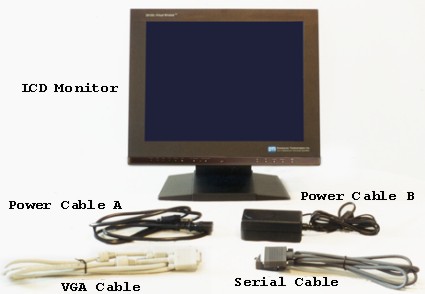DTI's Virtual Window 3D LCD Display
DTI 2015XLS Setup, Continued
The other application that comes on the CD is DTI's Interactive 3D Image Processing Utility, or DTINT32I. This allows you to create one stereo image from two bitmaps, one for the left eye perspective, and one for the right eye perspective. Probably the nicest feature of this is the option to do a very basic slide shows.
I used AutoCAD 2000, ran the Mad Onion benchmark demo, and Unreal Tournament and Rollcage to get a feel for the display. The display should work with DirectX 5.0 games and up so, it seemed more appropriate to test the results with something less cutting edge. Static images, a number of which are included on DTI's installation disk for demo purposes, work best. I have a feeling a lot of how it works for you will depend on how quickly your eyes, and brain maybe, adjust to the 3D effect.
The 3D works better when there isn't a lot going on in the background, or there is an obvious contrast between the foreground and background object. So, if you have an object in front of a plain background, the 3D experience is going to be much more noticeable than if you have a foreground object against a very busy background of textures, and explosions and activity. Which means that you lose the impact of seeing 3D in a practical gaming situation. However, that doesn't stop the 2015XLS from giving you a little jolt every time you switch to 3D as you see images appear to come out of the screen.
In full screen games you get the best experience, but in AutoCAD, or any other application where you may be working in a Window, you might be better off using the 2015XLS as a secondary display, and keeping the main application on a bigger, higher resolution display.
The screen defaults to 2D. In order to switch to 3D, something you can do on the fly, you have to change the monitor's settings from the front panel. The assumption has to be that you are using the display as a normal 2D LCD at other times, which seems to be part of the attraction of the 2015XLS, that it can be used for general everyday use, and specialized 3D viewing. When you switch to 3D you do notice the image dim, and the effect of switching back and forth between 2D and 3D is a little disconcerting as a result. It's a minor point, but it could be important if you were to use the display as your primary display for great lengths of time.
DTI 2015XLS Specs
The 2015XLS (image courtesy of DTI)
| Model | 2015XLS |
|---|---|
| Display Size | 15.0" |
| Display Area | 12.0" W x 9.0" H304.1 mm W x 228.1 mm H |
| Display Type | TFT LCD |
| User-Selectable Stereo Formats | Frame Sequential;Side-by-Side (left/right);Field Sequential (row interleaved)Side-by-Side (left/right)Top-and-Bottom (over/under) |
| Inputs | Analog RGB, 15-pinRS-232, 9-pin, for computer controlOptional video input |
| Pixel Pitch | 0.297 mm H x 0.297 mm V |
| Backlight | CCFL edgelight system |
| Contrast Ratio | 200:1 minimum, 300:1 typical |
| Brigthness | 2D: 250 cd/m23D: 86 cd/m2 |
| Included Accessories | AC cable; AC adapter; VGA cable; RS-232 cable; DTI CD ROM including 3D model viewing software, still image manipulation software, display adjustment software, sample 3D models, and still images; Quick Start guide; User Manual |
| Dimensions with stand | 14.3 x 15.1 x 6.7 inches HWD363 x 383.9 x 170 mm HWD |
| Weight | 17 lbs; 4.8 kg |
| Power Input | 12V/3.5A, 100-220 VAC |
| Power Consumption | 23 W max. |
| Weight | 20 lbs/9 kg |
| Power Consumption | 30 watts max. |
| Input Power | 115 VAC/1.5A or 230 |
There is an on screen menu display that gives you access to Brightness, Contrast, Auto Adjustment, Geometry, Color, and 2D/3D Function Selection. The 2D/3D Function Selection gives you the option of specifying the 3D format of the display, and let's you flip from 3D to 2D. In 3D mode, you can split the image up into top and bottom and side by side, and choose between frame sequential mode and field sequential mode.
Get Tom's Hardware's best news and in-depth reviews, straight to your inbox.
